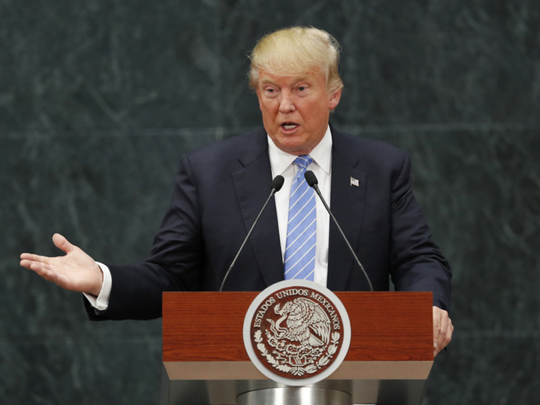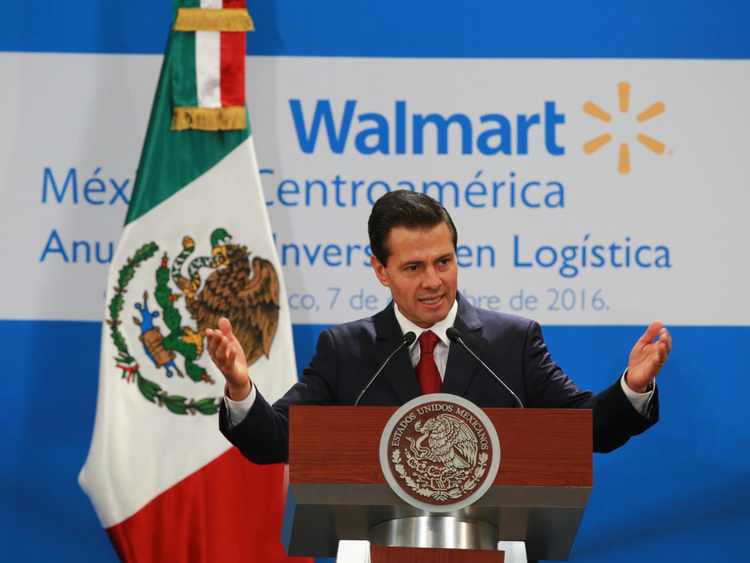
Donald Trump’s stunning electoral victory could very well transform the United States’ economic relations with the rest of the world. Perhaps the most dramatic changes will be felt by Mexico. During his election campaign, Trump proposed building a massive border wall, deporting millions of undocumented Mexican workers, renegotiating NAFTA, and imposing high tariffs of up to 35 percent on Mexican exports to the United States.
The wall may never be built because environmental groups will tie up the process in the courts. Large-scale deportations are also unlikely, given their cost and the likely vigorous litigation by advocacy groups. In time, any tariffs the new administration imposes on Mexican exports to the U.S. will probably be overturned by the World Trade Organization - assuming Trump doesn’t act on his threat to withdraw from this body as well.
In the short term, however, there is little to stop the Trump administration from renegotiating or abrogating NAFTA and imposing crippling trade restrictions on Mexico. Mexico’s ability to cope with the resulting shocks will largely depend whether it can implement urgently needed structural reforms. Unfortunately, the evidence to date suggests that progress has been minimal and is likely to remain so unless the country first addresses its problematic governance, particularly in the areas of corruption and rule of law.
At the start of his administration four years ago, President Enrique Pea Nieto announced an impressive set of reforms that aimed, among other things, to improve education and introduce competition into the telecommunications and oil sectors. The hope was that success in these areas would create the foundation for a virtuous circle, in which rising public trust and improved efficiency would boost economic growth and create momentum for additional reforms. To date, however, only the telecommunications reforms have been successfully implemented. The other efforts have stalled, and Pea Nieto’s disapproval rating has risen to 66 percent, the highest recorded for any Mexican president. This has much to do with allegations of widespread corruption in both his administration and his ruling PRI party.
Public trust in the Pea Nieto government has been undermined by a series of scandals. The first was its gross mishandling of the disappearance of 43 students at the hands of corrupt police in the state of Guerrero in September 2014. Next, there was a corruption scandal involving a conflict of interest when the first lady, Anglica Rivera, and Finance Minister Luis Videgaray received favors from a company bidding on government contracts. Most recently, the government has been rocked by links between organized crime and the former governor of Veracruz, Javier Duarte, a PRI member. Two other outgoing PRI governors are facing fraud charges.
While the Pea Nieto administration recently announced new reforms aimed at curbing corruption, the World Bank’s Governance Indicators show that since he assumed office, Mexico’s ranking on the world corruption index has declined considerably. Although Mexico’s ranking on the global rule of law index has improved incrementally over this period, the country still lags Brazil by a wide margin. With worsening corruption and sub-standard rule of law, Mexico’s inadequate governance structures have undermined its reform efforts.
Education reforms are a case in point. In 2012, Mexico’s educational system ranked a dismal 53rd out of the 65 OECD members - though it spends more on education per capita than anyone else in the group. To address this deficiency, in 2013, Pea Nieto introduced reforms designed to curb corruption, establish teaching standards, and require teacher competency tests, which teachers would have three tries to pass before being removed from the classroom. As of July 2015, only about 80 percent of the country’s public school teachers had taken the exam for the first time, and 46.8 percent failed. Furthermore, a 2015 report by the Mexican Federal Auditor’s Office revealed teachers’ unions and local authorities had misappropriated nearly $700 million from the educational sector. The audits also revealed that 1,906 “ghost” schools were receiving federal funds to pay non-existent teachers.
The education reforms have prompted a series of strikes by teachers and students, who claim that teaching standards and competency exams infringe on labor rights. When the strikes turned violent, the government, which had steadfastly refused to compromise, entered into discussions with the national teachers’ union, and rollbacks of the reform efforts are widely anticipated. The education fiasco can be directly linked to public’s lack of trust in the government. This gave the teacher’s union an opportunity to mobilize against the reforms. Unfortunately, failure in this area will hinder Mexico’s transition to higher value-added exports, as these products require workers with higher levels of technical training. Until Mexico’s educational system is capable of producing these critical inputs on a large scale, the country’s ability to shift from the U.S. market to participate in rapidly growing Asia-Pacific markets will be very limited.
Nor are Pea Nieto’s energy reforms living up to early expectations. The reforms were supposed to effectively end the 75-year monopoly of the state oil company, Pemex, over the domestic oil and gas sector. For the first time since the 1930s, nearly all levels of the energy production sector would be open to both domestic and foreign private investment. The idea was to attract enough funds to facilitate a much-needed expansion in production and revenues, which cover a large percentage of Mexico’s government expenditures. While it was hoped that exposing Pemex to competition would force the company to become less corrupt, more efficient, and increasingly transparent, this doesn’t seem to have occurred. In fact, accusations against management wrongdoing are on the rise. Pemex has also made scant progress in dealing with its red tape and limited productivity.
The 2014 oil price collapse, which curbed hoped-for private investment, hasn’t helped. As a result, international firms showed little interest in the initial bidding rounds for exploration acreage. In subsequent rounds, the government has offered more attractive terms, and international firms have appeared to be more receptive. But many remain leery of committing to the Mexican energy sector because of the high reputational risk posed by collaboration with Pemex, whose poor ethical standards give it low standing within the industry. Given these concerns, despite the recent successful bidding round, the private sector’s ability to meaningfully increase Mexico’s oil production is at least five to ten years away. Delays in energy reform will prolong government revenue shortfalls, thus slowing down infrastructure investment that is needed to increase the country’s competitiveness in external markets.
In retrospect, the government made a mistake by viewing reforms as a quick fix that could be introduced without first addressing Mexico’s underlying governance problems. The country has no choice but to reduce corruption and improve rule of law if it wishes to escape the “middle income trap,” a stage of development in which countries that lack a solid institutional foundation face diminishing returns on investment and slowing economic growth.
Signs of the trap are apparent in the low growth rates that have plagued Pea Nieto’s time in office. In the October 2016, the IMF lowered its 2016 GDP growth forecast for Mexico to 2.4 percent from the 2.6 percent predicted the previous January. In August 2016, following an earlier downgrade by Moody’s, S&P Global Ratings revised Mexico’s outlook from stable to negative. S&P warned the country had a one-in-three chance of a rating cut within the next two years due to substandard growth and rising sovereign borrowings, which it attributed to weak governance, corruption, and a rebound in organized crime and violence.
Mexico’s best - and perhaps only - hope for coping with the threat of intensified U.S. protectionism under a Trump administration is to speed up governance reform. As matters now stand, inefficiencies associated with corruption and patronage add to the cost of many Mexican exports. By addressing these problems, Mexico would gain the flexibility it needs to complete in non-U.S. markets while creating the institutional foundation to allow the country to move to the next stage of development irrespective of possible U.S. actions.
mexico-trump-comment












